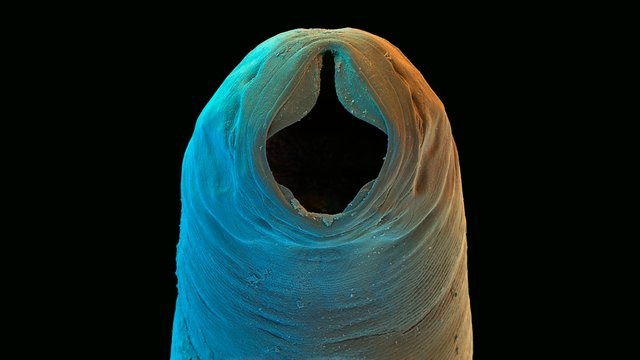How a Worm Gave the South a Bad Name
For more than three centuries, a plague of unshakable lethargy blanketed the American South.
It began with “ground itch,” a prickly tingling in the tender webs between the toes, which was soon followed by a dry cough. Weeks later, victims succumbed to an insatiable exhaustion and an impenetrable haziness of the mind that some called stupidity. Adults neglected their fields and children grew pale and listless. Victims developed grossly distended bellies and “angel wings”—emaciated shoulder blades accentuated by hunching. All gazed out dully from sunken sockets with a telltale “fish-eye” stare.
Image: https://tpc.googlesyndication.com/simgad/765615662978129497
The culprit behind “the germ of laziness,” as the South’s affliction was sometimes called, was Necator americanus—the American murderer. Better known today as the hookworm, millions of those bloodsucking parasites lived, fed, multiplied, and died within the guts of up to 40% of populations stretching from southeastern Texas to West Virginia. Hookworms stymied development throughout the region and bred stereotypes about lazy, moronic Southerners.

While the South eventually rid itself of hookworms, those parasites cost the region decades of development and bred widespread misconception about the people who lived there. Yet hookworm has not been defeated for good. Today, hundreds of millions of people in dozens of nations around the world suffer from hookworm infection. The South’s experience, measured in both its successes and pitfalls, can provide a rough blueprint of how to seek out and quash this “American murderer”—no matter where it is found around the world.
𝗔𝗻 𝗜𝗻𝘁𝗶𝗺𝗮𝘁𝗲 𝗥𝗲𝗹𝗮𝘁𝗶𝗼𝗻𝘀𝗵𝗶𝗽
In the South, tiny enemies seem to be everywhere. Mosquitoes sneak bites, roaches creep into bedrooms, chiggers bore into tender skin around panty lines, and parasitic worms invade vulnerable guts. As a child growing up in Mississippi with a Southern historian mother who had a fondness for hookworms, I became acquainted with those bloodsuckers at an early age. Hookworm was often an unappetizing topic of conversation around the dinner table, and knowledge of those parasites shaped Nuwer household conduct.
While all the neighborhood kids ran barefoot in the summer, for example, my mother did her best to intersect my sister and me as we bee-lined for the door, ready with pair of shoes and a warning: “You’ll get worms!” Our feet were not the only appendages she shielded from infection, however; fingernails underwent weekly clippings and cleanings to eliminate a potential conduit for eggs or larvae.
The proof of the pudding is in the eating, however, so despite these precautions my mother also went directly to the source, inspecting our rears for tiny, slithery bodies and our stool for traces of movement. (For the record: my sister did contract pinworms on one occasion, but to the best of my knowledge, I enjoyed a worm-free childhood.)